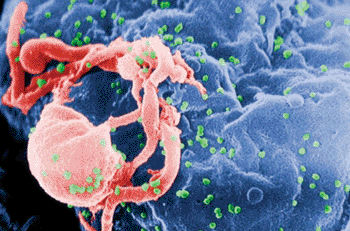Viral Outgrowth Assay Developed for Latent HIV
By LabMedica International staff writers
Posted on 14 Jun 2013
The development of a simpler assay for the latent reservoir of human immunodeficiency virus (HIV) has been identified as a major priority in the study of acquired immunodeficiency syndrome (AIDS). Posted on 14 Jun 2013
A rapid viral outgrowth assay that quantifies the frequency of cells that can release replication-competent virus following cellular activation has been developed and validated using a novel quantitative molecular technique.

Image: Scanning electron micrograph of HIV-1 virions budding from a lymphocyte (Photo courtesy of C. Goldsmith).
Scientists at Johns Hopkins University School of Medicine (Baltimore, MD, USA) enrolled 20 HIV-1 infected patients in a study and peripheral blood mononuclear cells (PBMC) were isolated using density gradient centrifugation. CD4+ T lymphocytes were enriched by negative depletion. For each patient, both a standard viral outgrowth assay and a MOLT-4/CCR5 viral outgrowth assay were performed using freshly purified resting CD4+ T lymphocytes obtained from a single blood draw. Resting CD4+ T lymphocytes were further enriched through negative depletion of cells using specific microbeads (Miltenyi Biotec; Auburn, CA, USA).
Complementary DNA (cDNA) was synthesized from the isolated HIV-1 RNA using the SuperScript III First-Strand Synthesis System (Invitrogen, Grand Island, NY, USA) with oligo-dT primers. The assay employs a novel quantitative reverse transcription polymerase chain reaction (RT-PCR) specific for polyadenylated HIV-1 RNA for virus detection, which is a more sensitive and cost-effective method to detect HIV-1 replication than expensive commercial enzyme-linked immunosorbent assay (ELISA) detection methods.
On average, viral outgrowth from the latent reservoir under conditions resembling the MOLT-4/CCR5 viral outgrowth assay was detectable by the HIV-1 specific RT-PCR assay after six days versus 10 days for HIV-1 p24 antigen ELISA. There was no significant difference between the frequency of latent infection of resting CD4+ T cells as measured at day seven using HIV-1 specific RT-PCR and at day 14 as measured by HIV-1 p24 antigen ELISA. The utilization of an RT-PCR based measurement for HIV-1 outgrowth not only allows more sensitive detection of viral replication but also will allow higher throughput measurement of HIV-1 replication.
The authors concluded that the MOLT-4/CCR5 utilizing viral outgrowth assay is the most rapid and scalable assay available for measuring the size of the HIV-1 latent reservoir. As such, they believe that this assay will be an indispensable tool in evaluating the success of strategies to curtail or eradicate the HIV-1 latent reservoir. The study was published on May 30, 2013, in the journal Public Library of Science Pathogens.
Related Links:
Johns Hopkins University School of Medicine
Miltenyi Biotec
Invitrogen




 assay.jpg)




 Analyzer.jpg)




